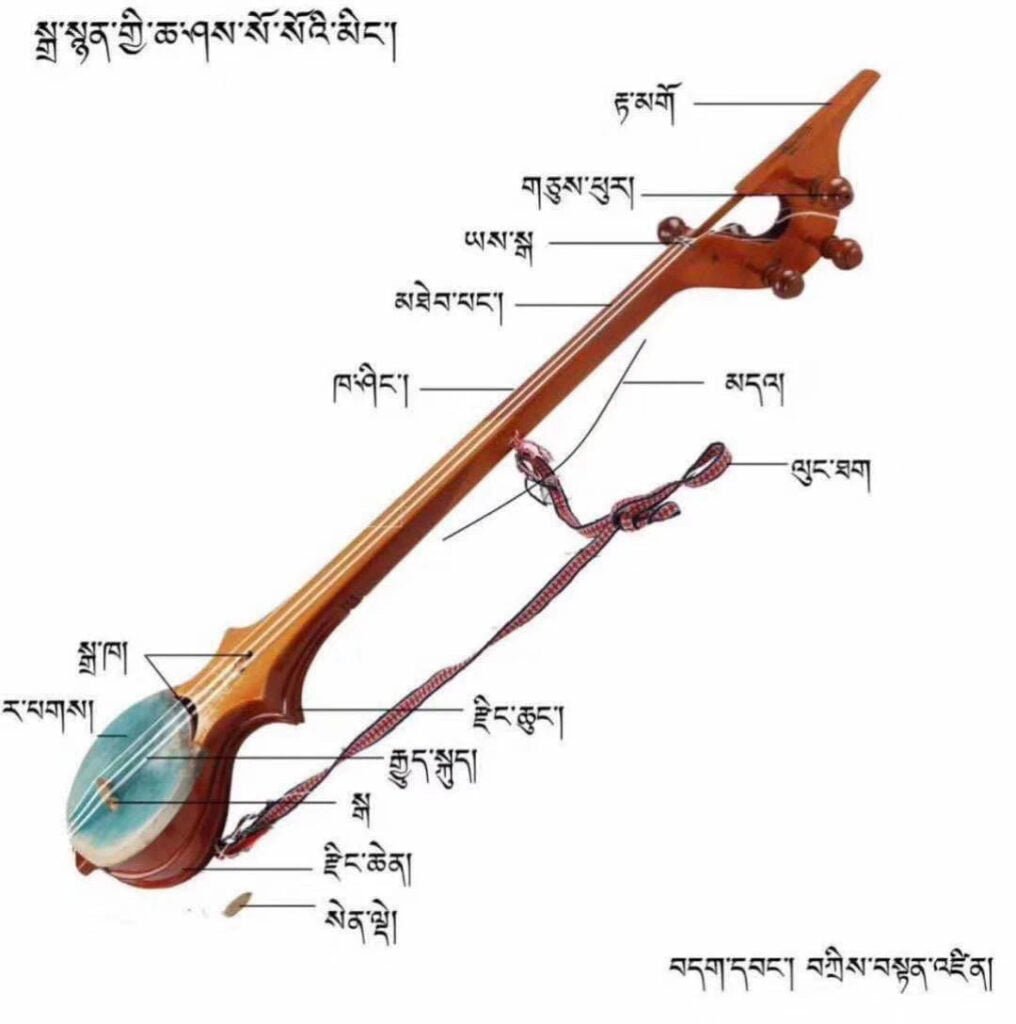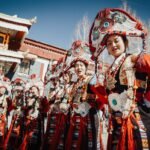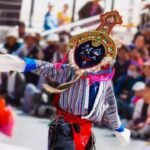The Tibetan Dramnyen, also known as the six-stringed qin, stands as the most beloved plucked instrument in traditional Tibetan singing and dancing, known as “Toshay.” The very name, Dramnyen, translates to “pleasant sound” in Tibetan, and it holds a special place in the hearts of the Tibetan people.
Historical Origins
Legend has it that in ancient times, the Qinghai-Tibet Plateau was once a vast sea. From its depths emerged a goddess of wondrous music, cradling the Dramnyen. She played this enchanting instrument with sheer delight, filling the air with mesmerizing melodies, and inspiring song and dance. This goddess, Saraswati, was born of a god and the sea, possessing an innate passion for poetry, literature, music, and art. Her divine talents earned her immense love from the Tibetan populace.

According to ancient documents, the Dramnyen traces its roots back to the Qinghai-Tibet Plateau. It’s a local musical instrument crafted by the Tibetan people themselves. Mr. Namgyal, a renowned national musician, confirmed this fact in his work, “Tibetan Traditional Musical Instruments.” More than 1,300 years ago, murals in the Jokhang Temple depicted the Tibetan king Songtsen Gampo playing the “Dramnyen” piano during grand celebrations. In addition, in front of Buddhist temples in Tibet, you can find murals and statues of the Four Heavenly Kings holding Dramnyen.
Production Process
The Dramnyen comes in various forms, such as the six-stringed qin, eight-stringed qin, and sixteen-stringed qin. Among these, the six-stringed qin reigns supreme, found widely throughout Tibet. The body of the instrument is meticulously crafted from wood, comprising a resonance box, a piano rod, and a headstock. It also boasts essential accessories, including strings, a bridge, pegs, picks, and shoulder straps.
The body is usually made from cypress, mahogany, walnut, and sandalwood, and the skin is often goatskin or python skin. The six-stringed version, approximately one meter long, features six tuning knobs, with the playing section housed in a wooden resonance box, providing a soft and delightful tone in a lightweight body.
Components of the Dramnyen

- Piano Body: The instrument’s body, crafted from wood, boasts a resonance box shaped like a cross-sectioned gourd, varying-length piano rods, and a headstock bent into a semicircle.
- Strings: These are commonly referred to as “Ju” or “Zigui” in the Diya area, denoting a rope made of goat intestines. Strings can be fashioned from various materials, including sheep intestines, beef tendons, silk threads, or metal strings. A “lift” at the bottom of the resonance box holds the strings in place, guiding them through the nut to the pegs on the headstock.
- Bridge: Positioned between the leather-covered resonance box and the stretched strings, a wooden bridge, known as “Ga” or “乜Ga” (meaning “saddle” or “lower saddle”), provides support, usually made of hardwood material.
- Pick: A small pick, “Senti,” hangs on the stringing device at the bottom of the Dramnyen resonance box. Typically made from hardwood, horn, or bone.
- Cross-Band: To facilitate playing during singing and dancing performances, a coloured forging or rope device, known as “Tianta,” meaning “strap,” is attached to the large resonance box, allowing the instrument to be hung diagonally for seamless performance.
The crafting of Dramnyen involves five primary processes:
- Hollowing the Wood: The most crucial step involves carving out the entire wooden body to form a resonance box.
- Making the Piano Rod: A hollow piano rod, functioning as a smaller resonance box, is crafted and matched with a panel, known as a “card.”
- Creating the “Daguo”: This element, shaped like a “horse head” or “dragon head,” is grafted onto the top of the fiddle pole.
- Constructing the Peg: A semicircular, backward-curved peg is attached to the headstock, featuring a string groove in the middle.
- String Selection: Various materials, including sheep intestine, beef tendon, silk thread, and more, are used to create the strings. Additionally, the Dramnyen is adorned with intricate patterns after its initial construction to enhance its visual appeal.

Inheritance and Protection
The Dramnyen represents a vital aspect of Tibetan culture, with deep roots and widespread popularity throughout Tibet. It has been an integral part of the Tibetan cultural tapestry, contributing to the development of numerous folk songs formed through extensive oral traditions. The seemingly straightforward combination of playing and singing, so intrinsic to Tibetan culture, reveals intricate aesthetic concepts, life values, and national pride.
Tibetans have long been known as people who dance as soon as they can walk and sing as soon as they can talk. Their cheerful and joyous disposition, stemming from the unique character of the Qinghai-Tibet Plateau, lends itself naturally to playing and singing. Dramnyen’s pleasant and soft tones provide a perfect medium for Tibetans to improvise and convey their emotions.
In 2014, the craftsmanship of Dramnyen was recognized as a national intangible cultural heritage project. Then, in November 2019, it earned a place on the “List of National Intangible Cultural Heritage Representative Project Protection Units,” with the Lazi County Bureau of Culture, Press, Publication, Radio, Film, and Television designated as a protection unit for “Dramnyen Making Skills.” Explore the enchanting world of Dramnyen and experience the rich cultural heritage it represents.
Geographic Diversity
The enchanting tones of the Dramnyen can be heard throughout major Tibetan regions in China. However, it predominantly thrives in Uizang and Houzang dialect areas, where it finds its most profound expression. While it also exists in the Kangba and Amdo dialect regions, its presence is comparatively smaller. Due to cultural distinctions and the instrument’s diverse functions across regions, various styles of Dramnyen have developed. These styles include Ali, Tingri, Lazi, Lhasa, Kampa, and Ando, each reflecting unique cultural nuances.

A Harmonious Instrument in Tibetan Life
Tibet is often described as an “ocean of singing and dancing,” where the Tibetan people infuse their lives with beautiful melodies and graceful dances. The Dramnyen plays a pivotal role in both singing and dancing. In Nangma (Tibetan classical song and dance forms) and Duixue (folk songs and dances popular across Tibet), the Dramnyen serves as a primary accompaniment to these artistic expressions. In the Amdo dialect region, it finds use as an accompanying instrument for playing and singing.
Early Dramnyen players were versatile, adopting both sitting and standing positions for their performances. While sitting, the player used a chair, tilted the instrument’s head to the left, supported the piano rod with their right hand, and employed the middle finger, ring finger, and index finger to press the strings. In their right hand, they held a horn pick.
Standing performers placed the Dramnyen on a colourful strap, hanging it over their shoulders with the instrument’s head facing upwards and to the left. They held the Qin in their left hand, pressed the strings, and played with the strings in their right hand, even allowing them to play while walking. Early performers could sing and dance simultaneously while playing the instrument, creating a mesmerizing spectacle.
FAQs
- What is the historical significance of Dramnyen in Tibetan culture?
- Dramnyen holds immense historical significance, with deep roots in Tibetan culture. It’s considered a symbol of artistic expression and emotional communication.
- Are there different types of Dramnyen, and if so, what distinguishes them?
- Yes, there are various types, including six-stringed, eight-stringed, and sixteen-stringed Dramnyen. They differ in the number of strings and the resulting tonal range.
- Why is Dramnyen considered an intangible cultural heritage project?
- The intricate craftsmanship and cultural importance of Dramnyen making are recognized as invaluable aspects of Tibetan heritage, worthy of preservation.
- Can anyone learn to play the Dramnyen, or is it reserved for specific individuals?
- While it requires skill and practice, Dramnyen is accessible to anyone interested in learning and embracing Tibetan musical traditions.
- What role does Dramnyen play in contemporary Tibetan culture?
- Dramnyen continues to be a vital part of Tibetan culture, featuring prominently in various events, celebrations

















